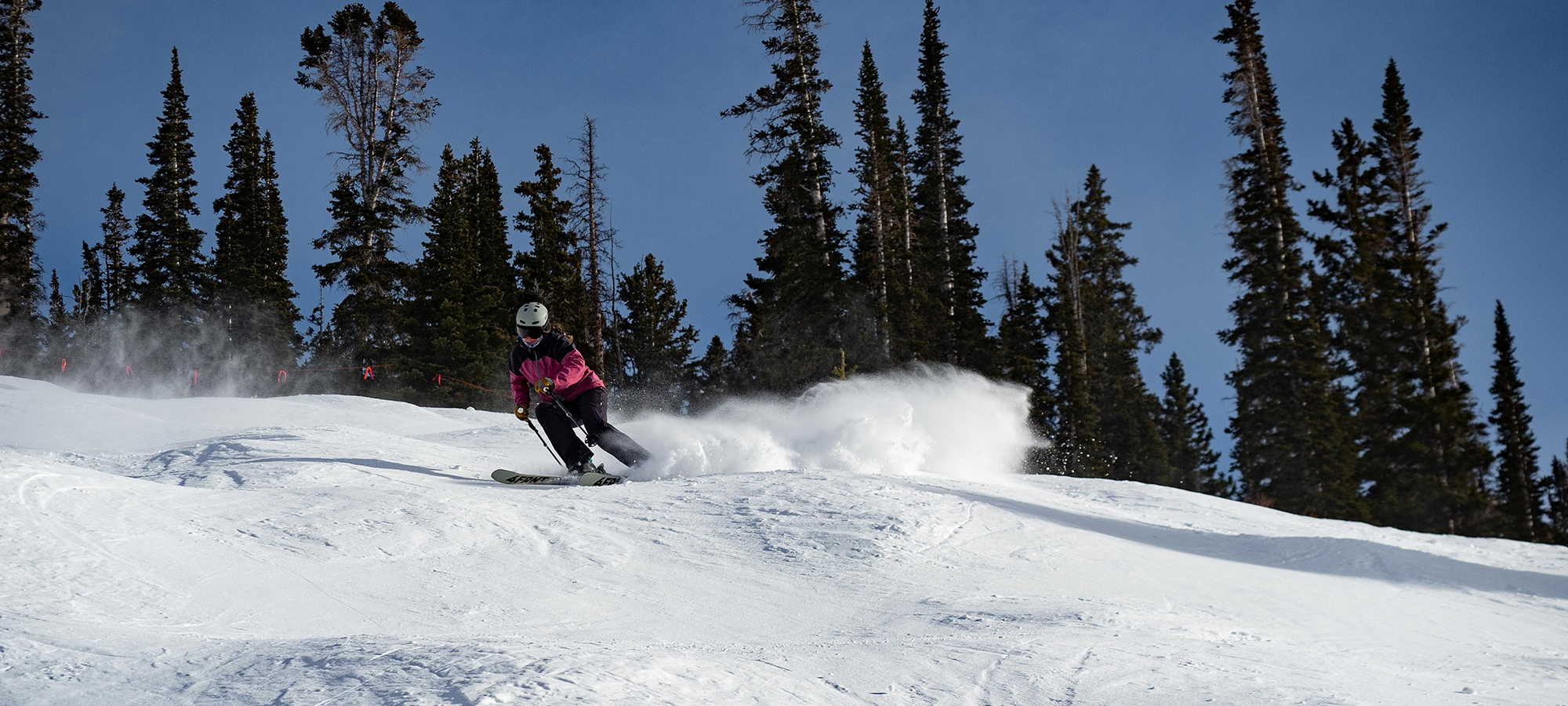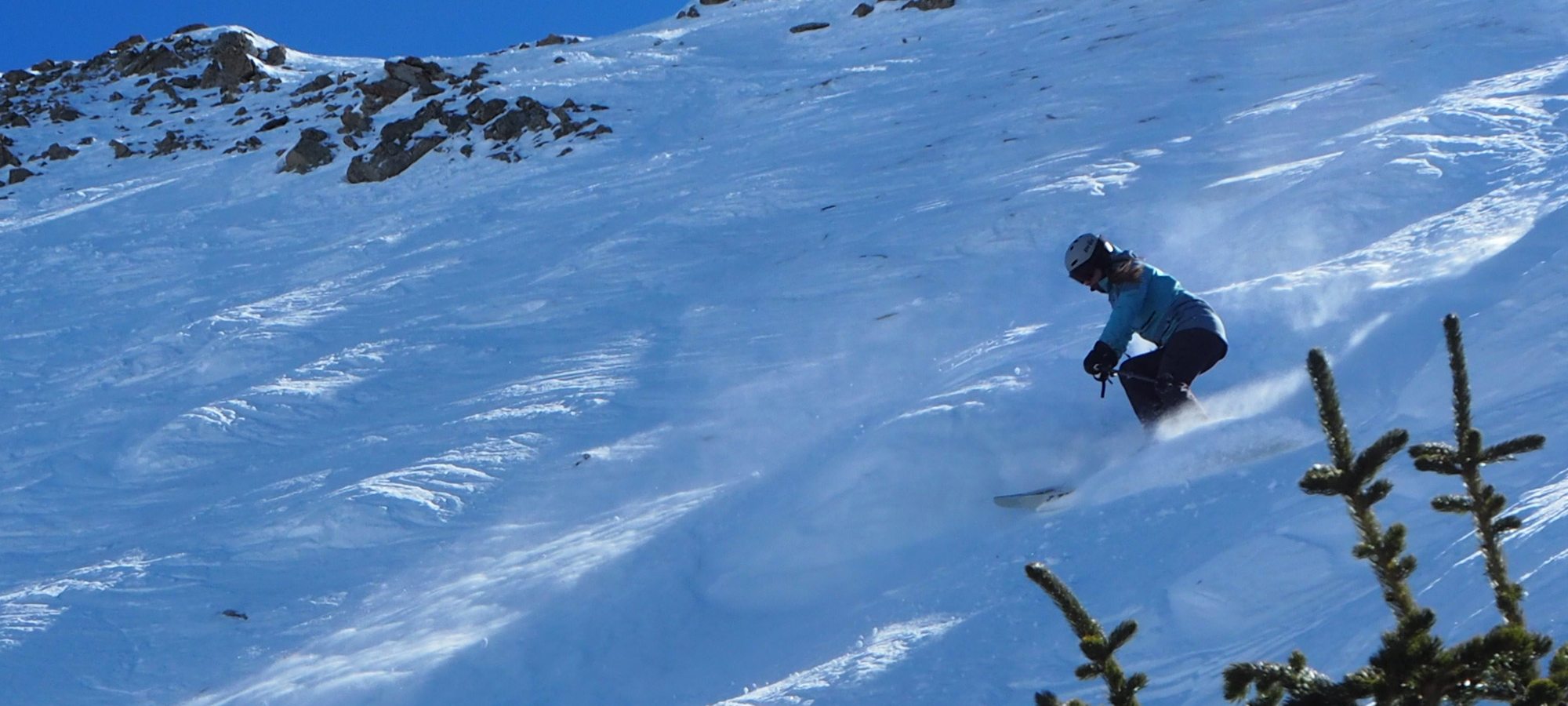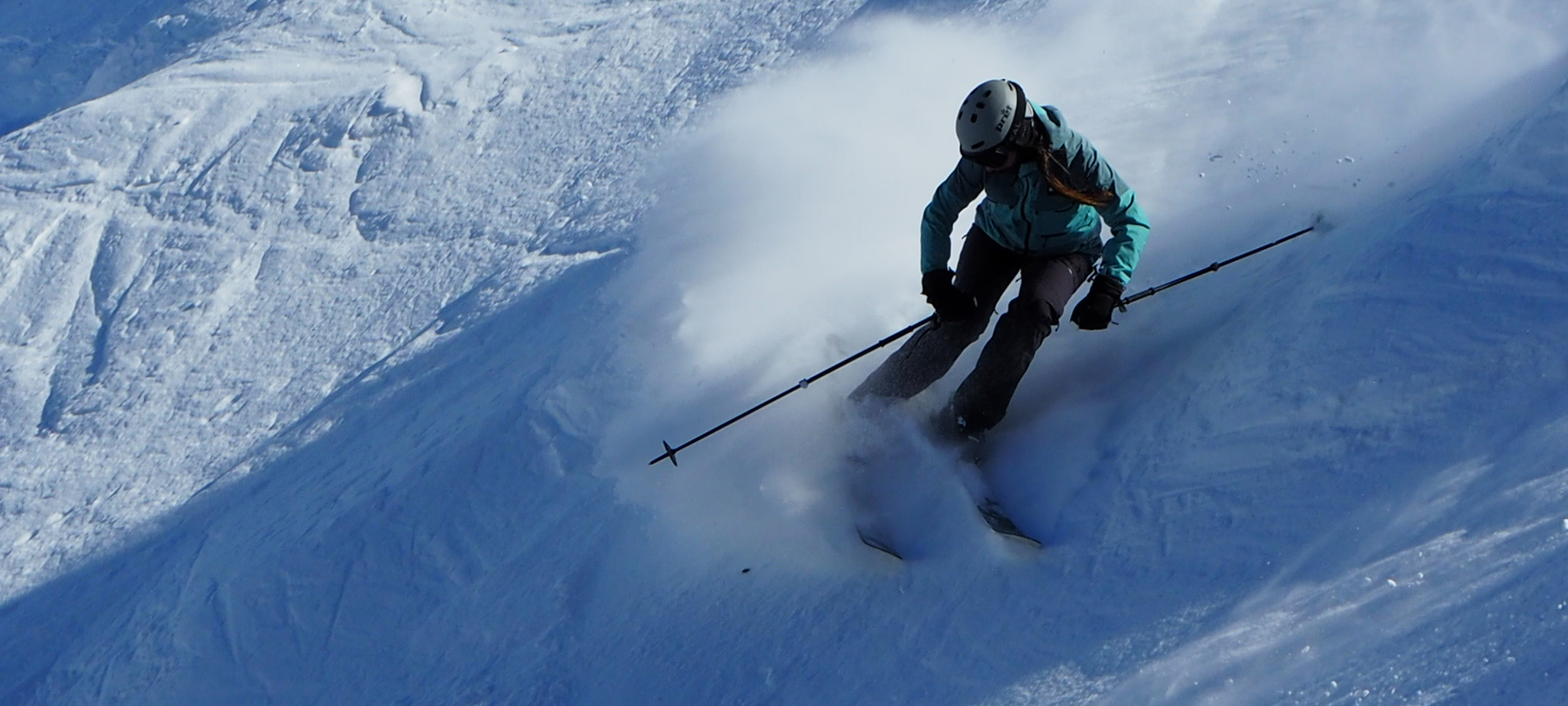Ski: 2021-2022 4FRNT MSP CC, 171 cm
Test Location: Mt. Crested Butte, Colorado
Days Skied: 18
Available Lengths: 159, 165, 171 cm
Blister’s Measured Tip-to-Tail Length: 170.1 cm
Blister’s Measured Weight per Ski: 1969 & 1988 grams
Stated Dimensions: 133-99-121 mm
Blister’s Measured Dimensions: 132.2-99.4-120.9 mm
Stated Sidecut Radius (171 cm): 17 meters
Measured Tip & Tail Splay (ski decambered): 53 / 12 mm
Measured Traditional Camber Underfoot: 2.5 mm
Core: Poplar + titanal (2 layers) + fiberglass laminate
Base: Sintered, 1.3 mm
Factory Recommended Mount Point: -7.55 cm from center; 77.5 cm from tail
Boots / Bindings: Nordica Promachine 115 W / Tyrolia Attack 13
Reviewer: 5’9”, 155 lbs / 175 cm, 70.3 kg
[Note: our review was conducted on the 20/21 MSP CC, which returns unchanged for 21/22, apart from new graphics.]

Intro
When I first got on the women’s 4FRNT MSP CC this season while coming off a knee injury, I didn’t know what exactly to expect since I hadn’t skied a 4FRNT ski before. What I did know was that I needed a ski that would help get me back to skiing steep, committing terrain and early season bumps the size of my car, without putting excess stress on my still-recovering knee.
Given that, the 99mm-wide MSP CC seemed like it could be a good tool for the job. 4FRNT claims that it has become popular “due to its incredibly versatile and intuitive feel,” and some of our other reviewers had said similar things about the unisex MSP 99.
After nearly 20 days skiing a variety of conditions, and terrain ranging from early season groomers and bumps to the new-to-me steep areas of Mount Crested Butte, the MSP CC has become one of my favorite and most reliable choices for this season.
Construction
The MSP CC shares the same core construction as the MSP 99, with a poplar wood core, two layers of titanal metal, fiberglass laminate, 1.3 mm sintered base, and 2 mm edges.
Shape & Rocker Profile
The MSP CC features a moderate rocker / camber / rocker profile, with rocker lines that are neither super deep nor super shallow. Its rocker profile is pretty similar overall to the Salomon QST Lumen 99, Nordica Santa Ana 98, and K2 Mindbender 98Ti Alliance. Those skis are also quite similar when it comes to shape — the MSP CC falls around the middle of the pack, with moderately tapered tips and tails.
Flex Pattern
Here’s how we’d characterize the flex pattern of the MSP CC:
Tips: 7
Shovels: 7-7.5
In Front of Toe Piece: 7.5-9.5
Underfoot: 9.5
Behind the Heel Piece: 9.5-8
Tails: 8
The 171 cm MSP CC’s flex pattern is quite similar to the 181 cm MSP 99’s, with both skis being pretty strong overall, but not overly burly.
Overall, the MSP CC’s flex pattern is quite similar to the Nordica Santa Ana 98. The Santa Ana 98 feels a bit stiffer though the back-half of the ski, while the MSP CC’s tips are a tiny bit stiffer.
Interestingly, the Blizzard Black Pearl 97 actually hand-flexes softer at the ends of its tips and tails, but on snow, it feels much stiffer and more demanding overall.
Weight
While it’s on the heavier end of the spectrum, the MSP CC strikes me as a good all-mountain option for someone who prioritizes stability and damping, but who still wants an easy-to-maneuver ride. Our pair of the 171 cm MSP CC came in around 1978 g per ski, which is pretty much in line with the Nordica Santa Ana 98 and Blizzard Black Pearl 97, though I’d say the MSP CC feels a bit lighter and more nimble than I’d expect for its weight.
For reference, here are a number of our measured weights (per ski in grams) for some notable skis. Keep in mind the length differences to try and keep things apples-to-apples.
1556 & 1575 Liberty Genesis 96, 165 cm (18/19–20/21)
1596 & 1608 Head Kore 93 W, 171 cm (19/20–20/21)
1626 & 1645 Line Pandora 104, 165 cm (18/19–21/22)
1651 & 1669 Moment Sierra, 172 cm (17/18–20/21)
1687 & 1695 Elan Ripstick 102 W, 170 cm (20/21–21/22)
1699 & 1753 Head Kore 99 W, 171 cm (20/21)
1709 & 1710 Blizzard Sheeva 10, 172 cm (17/18–21/22)
1762 & 1801 K2 Mindbender 98Ti Alliance, 168 cm (19/20–21/22)
1792 & 1792 Nordica Santa Ana 104 Free, 172 cm (20/21–21/22)
1797 & 1839 Rossignol BLACKOPS Rallybird, 170 cm (20/21–21/22)
1812 & 1817 Salomon Stance W 94, 174 cm (20/21–21/22)
1831 & 1852 Rossignol BLACKOPS Rallybird Ti, 171 cm (20/21–21/22)
1881 & 1895 Salomon QST Lumen 99, 174 cm (19/20–21/22)
1903 & 1917 Nordica Santa Ana 93, 172 cm (20/21–21/22)
1917 & 1935 Nordica Santa Ana 98, 172 cm (20/21–21/22)
1955 & 1990 Coalition Snow SOS, 173 cm (19/20–20/21)
1969 & 1988 4FRNT MSP CC, 171 cm (20/21–21/22)
2015 & 2024 Blizzard Black Pearl 97, 171 cm (20/21–21/22)
2104 & 2115 Volkl Secret 102, 170 cm (19/20–21/22)
FULL REVIEW
Groomers
Kara Williard (5’9”, 155 lbs / 175 cm, 70.3 kg): I was pleasantly surprised by the MSP CC’s performance on groomers. After laying down a couple of carves on the MSP CC, my first thought was “wow, I feel pretty balanced on this ski.”
On the 171 cm MSP CC, it was easy to access the full flex of the ski in a way that felt natural, intuitive, and willing to work with my slightly strange and imbalanced stance (a boot-fit-related problem you may have heard me mention in other reviews). The MSP CC didn’t require excessive inputs or an exaggerated forward stance, which is sometimes how I find myself skiing when trying to drive a ski.
Contrary to what some of our reviewers said about the MSP 99, I actually thought the MSP CC felt pretty lively coming out of each carve. I found the Nordica Santa Ana 98 to feel a bit more energetic than the MSP CC during turn transitions at high speeds, but this difference was subtle and overall the MSP CC felt intuitive and poppy on piste.
At high speeds, the MSP CC was composed, damp, and I rarely felt like I was approaching its top end of stability, other than when the groomers got really icy. On icy conditions, I would’ve preferred a stiffer ski with a tighter radius, mostly for a little more quickness edge-to-edge and easier turn initiation. The Blizzard Black Pearl 97 felt a bit more composed and reliable on super firm conditions, though the MSP CC was much more forgiving than that ski when I wanted to take it easy or head off piste.
During the Blister Summit, I also had the chance to try the MSP 99 in a 181 cm length, and did appreciate the longer platform when skiing fast on firm groomers. But as someone who is often caught between women-specific skis and longer unisex skis, the 171 cm MSP CC was impressive in that I rarely felt limited by its high-speed stability.
Compared to a narrower ski like 172 cm Atomic Maven 93C, the MSP CC isn’t quite as quick to initiate a carved turn nor as quick edge to edge, and a bit less energetic through the transition. As I alluded to above, the Blizzard Black Pearl 97 is notably stiffer and more demanding than the MPS CC on groomers, which I found to be great during high-speed, early morning groomer laps, but less so as I was skiing down on tired legs at the end of the day.
Moguls, Trees, & Tight Terrain
The MSP CC shined in moguls, trees, and tight terrain, especially when I found myself skiing all three at once. To be transparent, my confidence has been all over the place this season due to my injury comeback. So while I want a ski that feels stable and supportive as I navigate the technical terrain of Crested Butte, I also want something that’s forgiving enough to ski long bump lines without being overly demanding or tough on my knee. The MSP CC became my top choice when it came to getting back up to my preferred level of skiing in more demanding and technical terrain.
Despite being on the heavier end, the MSP CC feels pretty quick and requires minimal effort to drive from one turn to the next. It was easy to hop around and jump turn on this ski, which proved to be a necessity as I learned the terrain of Mount Crested Butte. I’ve been relying on being able to pivot over the tops of moguls (rather than really sticking to the troughs) to put a bit less strain on my knee, and the MSP CC worked well with this style.
The MSP CC’s tail is also just right for me — it’s easy to quickly release from the turn and pivot, while still feeling stable and secure when engaging the full effective edge. I could alternate between carving, slashing, and jump turns with ease.
One of my go-to skis for navigating tight, challenging terrain is the 180 cm Blizzard Sheeva 10, since it provides support through the midsection, really easy initiation through the shovel, and easy release of the tails. I found the MSP CC to provide a lot of the same, other than its less-rockered tail feeling a little less easy to release, and consequently found myself reverting to more of a hop motion to move through the tightest spots. But since the 171 cm MSP CC is and feels noticeably shorter than the 180 cm Sheeva 10, it balanced out and still made me similarly comfortable and confident in tight spots.
Powder
For a ~100mm-wide ski, the MSP CC does a pretty good job of gliding atop fresh snow without feeling like it wants to dive beneath the soft stuff. Granted, I haven’t had it in any exceptionally deep conditions (I’ve used it in up to about 10 in / 25 cm of fresh snow). But on the several soft-ish days I did have, the MSP CC was fun and playful while maintaining enough float to keep me from having to really work to keep myself above the snow, as much as can be expected with a ski of this width.
I had the opportunity to demo the 181 cm MSP 107 at the Bister Summit, and I was really impressed by the versatility of this wider variation within the MSP family. Given how well that ski handled firmer conditions, I would gravitate towards the 107 if I was looking for a 1-ski quiver that I’d use every single day, including deep ones. For its width, the MSP CC was still fun in powder, but I think it would work best as an all-mountain ski for more typical conditions, and be supplemented with something a little wider for the truly deep days. But for the occasional moderate pow day, the MSP CC can still be quite fun.
Soft Chop
The MSP CC is a fun and confidence-inspiring ski in soft chop. It feels smooth in variable and choppy conditions without being overly demanding. The MSP CC provides nice suspension when the snow is inconsistent, creating a fluid, intuitive ride when moving from soft snow to firm troughs. It’s substantial enough to charge quite fast through choppy conditions, but I also don’t feel like I’m working particularly hard to ski it, providing a nice balance of being forgiving yet smooth when conditions move from soft to firmer chop.
When it comes to its balance of maneuverability and stability, the 171 cm MSP CC reminds me of the 172 cm Nordica Santa Ana 98 and 180 cm Blizzard Sheeva 10. These are all skis I can rely on for highly variable conditions, allowing for a mix of short, quick turns and faster, longer turns where I’m really pushing them. I found the overall stability of the MSP CC to feel really comparable to the 180 cm Sheeva 10. The Santa Ana 98 is still my go-to for skiing fast in chop, as it still feels the smoothest and provides the best suspension out of any women’s ski I’ve been on. Overall, though, the MSP CC still provided very good stability (especially compared to the many lighter women’s skis in this class) without being demanding through chop. And the differences between the stability of the Sheeva 10, Santa Ana 98, and MSP CC are minor enough to leave me feeling confident on any of the three in variable conditions.
Who It’s For?
The MSP CC is a versatile all-mountain ski that can feel fun, stable, and comfortable in pretty much any condition. There are some skis (e.g., Blizzard Black Pearl 97, Volkl Secret 102) that feel more stable at very high speeds and in rougher conditions, but they’re also significantly more demanding and challenging to ski. The MSP CC feels supportive, stiff, and damp enough to provide confidence when I am skiing at my best, but is also happy to take things easy when I am feeling tired or less confident in my knee.
As a result, the MSP CC seems like a wonderful transition ski for someone who is continuously seeking to improve but who doesn’t want to feel constantly challenged by their daily driver. At the same time, the MSP CC’s high-speed stability is impressive. It felt accessible when I wasn’t looking to charge, but was damp and stable enough to take out on more challenging terrain, charge on groomers, or push speed and technique in moguls or tight terrain.
The MSP CC is worth a good look from someone who is looking for an all-mountain ski that will balance play with performance. There are wider skis (like the 4FRNT MSP 107) that may make more sense for someone regularly skiing powder. And there are narrower options that would be better if you spend most of your time on piste and prioritize edge hold and edge-to-edge quickness. But the MSP CC feels comfortable in the majority of resort conditions, making it a very good 1-ski quiver option. I feel like a lot of women could hop on the MSP CC and find it to be a well-rounded and overall fun ski.
While I think there are many women who would get along great with the MSP CC, there are stiffer, heavier skis that provide more stability to expert-level skiers, such as the Blizzard Black Pearl 97 or the Volkl Secret 102. And for someone who finds themselves more on piste or skiing minimal soft snow, I may also pick something a bit narrower such as the Atomic Maven 93C or Blizzard Black Pearl 88.
But for someone who is seeking a supportive and confidence-inspiring ski while maintaining a degree of playfulness and maneuverability, I found the MSP CC to be a very versatile option. Going off my own experience, having started this season with very little confidence and working my way back up to skiing the abundance of challenging terrain at Crested Butte, the MSP CC was pretty ideal. It has a big sweet spot and can work very well for women who are seeking improvement, want to expand on skills or terrain, but who also don’t want to outgrow a more forgiving, less stable ski.
Bottom Line
Regardless of the day or conditions, the 4FRNT MSP CC is a ski that I could be pretty happy on. Overall, this ski just provides balance — a balance of playfulness / maneuverability and smoothness / stability. It is a well-rounded ski that caters to a lot of skiing styles and skill levels, while still being composed enough to be pushed hard in a variety of conditions and terrain.





So glad you reviewed this ski. I bought the previous version MSP-W for my daughter in 2017. She pretty much experienced the ski as you described – great for everything except deep POW. She is now looking at going to a two ski quiver – something capable in deep POW and some touring in soft conditions. The MSP is pretty solid for just about everything else (icy is rare where we are). Now that Blister can put the MSP CC on their spectrum it should help our decision on the next ski for her quiver.